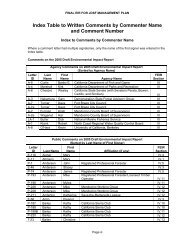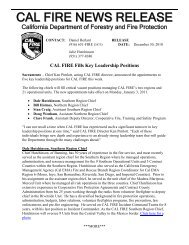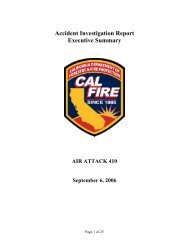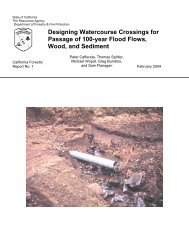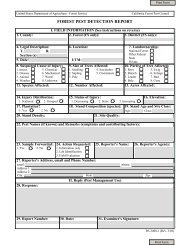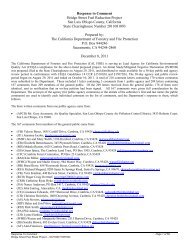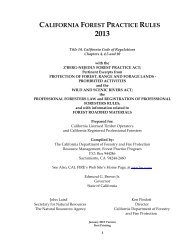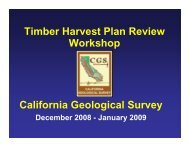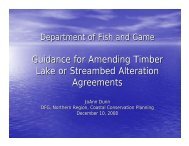Boggs Mountain Demonstration State Forest Draft ... - Cal Fire
Boggs Mountain Demonstration State Forest Draft ... - Cal Fire
Boggs Mountain Demonstration State Forest Draft ... - Cal Fire
Create successful ePaper yourself
Turn your PDF publications into a flip-book with our unique Google optimized e-Paper software.
<strong>Boggs</strong> <strong>Mountain</strong> <strong>Demonstration</strong> <strong>State</strong> <strong>Forest</strong> <strong>Draft</strong> Management Plan, June 2008<br />
Ripping is performed at all fill sites (including where outsloping occurs) prior to the application of<br />
fill, and to all road and landing surfaces whether they are to be cross road drained or outsloped.<br />
Road and landing surfaces should be ripped before any other treatment is applied. The ripping<br />
depth and the maximum spacing between adjacent ripper shank passes shall average 1.5 feet<br />
and spacing shall not exceed 2.0 feet.<br />
Inboard ditches are not to be ripped where cross road drains are prescribed, nor are the<br />
remaining benches ripped along reaches where Exported Outsloping (EOS) is to be performed. In<br />
addition, the surface of stream crossing fills and other road fills, which are to be completely<br />
excavated, need not be ripped if the fill is to be removed as a part of the rehabilitation treatment.<br />
In some cases, decompaction of these surfaces may make later excavations easier to<br />
accomplish.<br />
2. Cross Road Drains (XRD)<br />
A cross-road drain is a deeply cut ditch, excavated across a road surface, which drains the road<br />
bed and inboard ditch. Cross road drains are more substantial and deeper than conventional<br />
waterbars used to drain forest and ranch roads. Well constructed cross-road drains will often be<br />
deep enough to prevent vehicular access to an area. Cross-road drains are typically constructed<br />
(excavated) using a tractor, an hydraulic excavator or a backhoe.<br />
Spacing of cross-road drains is highly dependent on the permeability and erodibility of the soil,<br />
which is exposed on the road surface. Drains in stable, forested areas may be spaced<br />
approximately 200 feet apart when road grades are less than 6%, and roughly 100 feet apart<br />
when road grades exceed 6%. In areas of erodible, decomposed granitic soils, road surfaces<br />
shall be drained at intervals not exceeding 50 feet and more frequently if local soil conditions and<br />
road gradients dictate.<br />
Each cross-road drain shall be free draining for its entire length, and have a uniform grade<br />
approximately equivalent to the gradient of the ditch or adjacent road surface, which flows into the<br />
cross-road drain. The depth of the drain at its inlet side should equal the existing inboard ditch<br />
level, but shall never be less than 18 inches. In all cases, cross-road drains on ditched roads shall<br />
be deep enough to intercept all ditch flow.<br />
Spoil is placed, compacted and smoothed on the downhill side of the excavated drain as a berm.<br />
Compacted fill and spoil is also used to completely fill the ditch at the drain inlet (where the drain<br />
intercepts the inboard ditch) to prevent ditch flow from bypassing the structure’s inlet. Side-bank<br />
steepness along the drain should not exceed 50%. Existing inboard ditches are left undisturbed<br />
and free flowing to each drain.<br />
No more than 15% of the total excavated volume of each cross-road drain may be sidecast at the<br />
drain outlet (there is a tendency to sidecast more material when the drain is built by a tractor). In<br />
areas underlain by decomposed granitic soils or other highly erodible soil, or where the drain is to<br />
discharge in close proximity to a stream channel, sidecasting shall be avoided. This largely<br />
dictates the use excavators and backhoes.<br />
Cross-road drains shall not discharge onto the sideslopes of freshly excavated stream crossings,<br />
or onto long reaches of bare, unprotected slopes. On a site-specific basis, energy dissipation<br />
(rock armor, secured slash or other suitable materials) will be required to control erosion at the<br />
outlet of the cross-road drain.<br />
3. Waterbars<br />
A waterbar is a shallow ditch excavated at an angle across a road or trail to drain surface runoff.<br />
They are usually built on seasonal or temporary roads, which are to receive little or no traffic<br />
58



